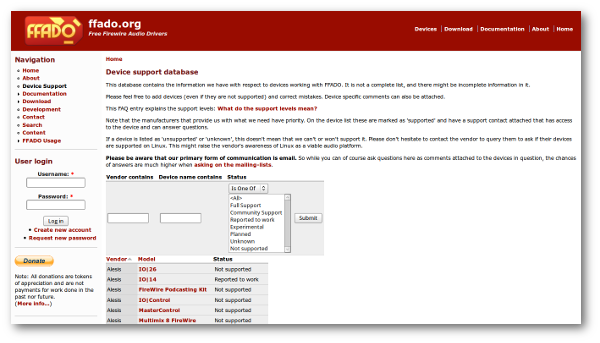Updated: Fri, 2014-11-14 13:54
Due to Linux audio's flexibility, very modular set ups are possible. Session management makes this easy by remembering software and their connections. You can launch various programs, connect them up and have you session manager remember, and later, relaunch the whole session, connections included. Some popular session management tools include Non Session Manager (NSM), Ladish and Jack session.
Updated: Tue, 2014-08-19 09:40
Phantom power is a 48v power supply used to power certain microphones (condenser), active DI boxes, etc. Most preamps/audio interfaces will include an on/off switch for this.
Updated: Tue, 2015-01-27 11:50
A digital to analog converter converts a digital signal to an audio signal. A simple example of this is the speaker out on your computers soundcard. A soundcard that has both A to D and D to A converters can be used to send audio to an outboard unit, eg. A reverb unit, and to send it back into the computer again (see inserts).
Updated: Tue, 2014-08-19 07:04
Soundcards have two main stages, preamp and an analog to digital conversion stage. The preamp boosts the signal and the A to D stage converts that usable signal into the digital domain, which the computer can then process. Some soundcards come with only analog to digital converts, eg. Delta 1010, some RME interfaces, etc. These require external preamps.
Updated: Wed, 2014-08-13 15:32
A preamp boosts the input signal, from a mic or instrument, to a usable level. Most audio interfaces include a preamp.
Updated: Thu, 2014-11-06 10:15
A device that gets audio in and out of your computer. All computers and laptops will have a basic built in sound card that will handle inputs (mic/line in) and outputs (to speakers/headphones). For professional audio you will need an additional soundcard/interface. These comes in various forms, USB, Firewire and PCI devices.
Understanding recording hardware
Updated: Tue, 2014-08-19 07:12
FFADO stands for Free FireWire Audio Drivers. This is an open source device driver backend for JACK. If you want to use a firewire interface, check out the FFADO website to see which devices are supported.

Updated: Tue, 2014-08-19 07:20
Pulse audio is a sound server that uses ALSA as it's backend. It is more geared towards general desktop audio. While it is useful for these purposes, pulse audio isn't used for any audio production software.
Updated: Thu, 2014-11-13 14:38
The Jack Audio Connection Kit is a professional sound server for low latency audio and MIDI connections. When running JACK you can interconnect audio and MIDI ports between any JACK aware programs. It is a very flexible system that can allow for very modular set ups, but is also used to manage connections within various pieces of software, eg. Ardour and Qtractor.
Updated: Tue, 2014-08-19 07:03
The Advanced Linux Sound Architecture is a audio framework, which is part of the Linux kernel. Both JACK and Pulse Audio use ALSA as their backend. Unless you are using a firewire device (see FFADO), it is ALSA that you will be looking at to see if your audio interface is supported. ALSA also has MIDI device support. A list of ALSA supported audio interfaces can be found on the ALSA website.
Pages